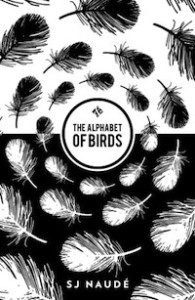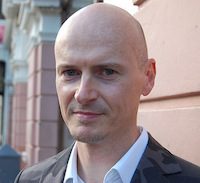
At the end of SJ Naudé’s story collection The Alphabet of Birds, an older man goes to a student drama festival. Despite his ennui, one dance performance stands out: “The kind of movement piece that does not create abstract shapes, but is built around the temperament of individual dancers. The risk of injury, of damage, provides the main source of energy.” It was a feeling I recognized in myself as well: the idea that art, today, is too easily satisfied by productions of beauty and technical mastery. The more compelling moment, in our era, is that of a body or a soul pushed to its limits, as if the artistic process were also, in the most concrete and dangerous sense, a test of the artist himself. This description of dance, indeed, could double as a description for Naudé’s narratives in this book: “Dancers throwing their bodies frenziedly against the floor, the escaping breaths sounding like something between a sigh and a hiccup . . . The audience shrinking away, tingling, imagining their own bodies into the dancers’ . . .”
Is this what a story should be, what we as an audience should experience in relation to a short story? Genuine risk? An encounter with mortality that we fear and envision, re-envision? A test not only of the artist but of ourselves?
So many of us, throughout our lives, come up against these limits and edges as if our world was an extension of modern dance, a stage, its inhabitants far more than actors. Rather than concrete plot, constant collisions with other people.
This means our lives cannot and should not be neatly organized into formulaic fairy tales and legends. Naudé understands this keenly, and so tangled and unresolved and crucial relationships become the driving force of his stories. The masterful “War, Blossoms” gives us a narrator suddenly forced to care for his dying mother in Cape Town, all the while fending off an old, half-forgotten friend who has inexplicably arrived from Japan. A woman, Ondien, struggles with her fraying musical performances (in “VNLS”) and, in another story, begins to make peace with her siblings (“Mother’s Quartet”). And in “The Noise Machine,” which opens the collection, two men enter a party within the courtyard of an Italian villa, and quickly become swallowed up within the various conversations there. It is a full third of the way through the story before these two meet properly:
The man smiles a sly smile against the reflection, as if saying: No, recklessness.
“You are Tom,” Chris says.
“I am Tom.” It sounds as if his tone is coupled with the raising of an eyebrow, but he has stepped back, into the deeper shadows, his face now a void.
“Fred mentioned you.” Chris leans forward . . .
“You are Tom” carries remarkable weight at this moment; it is very nearly a performative utterance that transforms these two men, who we have glimpsed and come to understand as strangers, into speakers cognizant of each other. But then, a few pages later, their relationship shifts again, somehow even more dramatically:
With the lazy, indifferent insistence of a child stirring in its sleep, Tom’s fingers work their way up Chris’s spine to his neck.
“Christiaan,” Tom says, whispering heavily, “little Christiaan.”
In the moment before Tom says his name (his vertebrae a string of coals), Chris knows exactly who it is: Tommie. Yes, Tommie from his school days.
In this way, the two men slowly begin to excavate the depths of their past, and the divergent roads they took away from each other. These odd encounters might eventually resolve into more comfortably archetypal relationships, but there is a strange beauty, a keenly felt honesty, in the way Naudé draws attention to these liminal meetings on the threshold between ignorance and recognition.
Everywhere various modes are jostling uncomfortably against each other. Tom and Chris meet each other in a secluded Italian villa with “shutters closed against the lorries and the factories, dust and ash settling on the garden.” In Ondien’s stories, the three musicians comprising VNLS (the acronym for the band “Victorian Native Ladies’ Society”) interweave “Western club music with instrumentation from North and West Africa, with kwaito and township elements” until they travel from Paris to Cape Town and bring in “Nigerian soul layered over London electro-pop, influences of raga . . . Lyrics in Cape Afrikaans.” The story “A Master from Germany” creates a fractured, Cubist portrait of the protagonist’s life by juxtaposing various moments and etching them in sharp relief against each other.

Indeed, this discontinuity, both within the book’s form as a collection of only-partly-linked stories and within the stories themselves, feels like a natural, literary extension of modern dance. If life is discontinuous, then every juncture presents itself as a potential for disaster, or salvation.
Oddly enough, some of these various juxtapositions seem far more subdued. Sexuality, for example. Nearly every story in this collection centers on same-sex male love, and yet it does not seem surprising or out of place. The men are simply living lives that become dangerous outside the arena of love.
Language, too, becomes neutralized. Entering South Africa’s borders, it is hard to miss the various signs written in three or even four languages. English is only the fourth most common first language there, and only one of eleven official languages; far more people in the country grew up speaking Zulu or Xhosa or that strange daughter-language of Dutch, Afrikaans. It is far more common for them to write in those languages, too. But somehow this linguistic variety, although hinted at within Naudé’s stories, does not sustain the author’s attention, or command our own.
“These stories are often foreign to Afrikaans,” SJ Naudé admitted of the seven stories comprising Alfabet van die voels, the Afrikaans original of The Alphabet of Birds. Consequently, “the [Afrikaans] language had to bend somewhat uncomfortably around them.” But translating his own stories may have been easier as a result: “they were already straining at the Afrikaans chain, gravitating towards English, which has long been adapting to a great variety of textures.”
Perhaps this subtle and yet logical relationship between a language and the world it describes is why the two longest and most intricate stories of The Alphabet of Birds are set in South Africa—as if the keener relationship between the country and the language had given Naudé’s pen freer rein. At nearly sixty pages, “Van” is more a novella than a short story, and it pulls us deep into South Africa—not the hubbub of Cape Town and Johannesburg, but the rural outposts, where HIV-positive patients are treated, and where corruption runs so rampant that a doctor, Sandrien, cannot get antiretrovirals unless she has something to offer the self-interested officials. In contrast, she constantly abnegates herself, forgoing chemotherapy for her cancer in order to tend to her rural patients. Sandrien’s angry actions reverberate many stories later, encroaching upon Ondien’s South-African experience in “VNLS” and bringing her closer to the events of “Mother’s Quartet.” Indeed, this division between the deeply interconnected South Africa stories and the more stochastic stories set all around the world bears some parallel to Naudé’s own life. “I spent my childhood in South Africa, but much of my adult life elsewhere,” Naudé told Ivan Vladislavić in an interview. “I don’t particularly like the category of ‘diasporic literature’, as it suggests a state of limbo from which the author may never escape, but it might be of some use.”
There is no limbo here; only the sharp edge of a knife, and on each side equally strange realities. Naudé’s The Alphabet of Birds display a dizzying array of textures, refracting the various facts and facets of our microcosmos. Naudé’s book becomes a meditation on the nature of loss, a striking series of portraits that reflects, with full honesty, without sentimentality, the constancy of the human condition. For that is the ultimate end of modern dance and contemporary existence: the body crushed against the floor, the life crushed against the world.
“What are we loosening ourselves for, what are we preparing for?” one of the characters in the book’s final story asks. He receives no answer, but notices on the final page how “the waste is piling up in this city . . . relics. Simultaneously recognizable and unrecognizable. One big performance space.” The answer this character needs is within the words of the book itself. Naudé’s stories loosen us for the dangers of reality, prepare us to risk everything we have for the sake of art.




